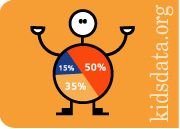The
California Index of Child and Youth Well-Being
..................................................................................................................................................................................................................
Projections of the Current Economic Recession
Given the likelihood that the current economic recession could have wide-ranging effects on child well-being, this study, in addition to examining trends from 1995 to 2006, also projects poverty rates through 2012 for the state, the Bay Area, and Los Angeles County.
In California in 2008, the most recent year for which data are available, 18.5% of children lived below the federal poverty level of roughly $22,000 for a family of four. Using the economic projection methods noted in the methodology, the poverty rate is estimated to rise to a high of 27% in 2010, before falling to 24% in 2012, meaning the impact of the current economic recession likely will be long-lasting for California's children.
In Los Angeles County, the poverty rate was 21.9% in 2008 – and that rate is expected to climb to 35% in 2010, then decline to roughly 30-32% in 2012. This could mean that in the county that is home to more than 25% of California’s children, nearly one out of every three kids will be living below the federal poverty level.
More modest increases in child poverty are projected for the higher-income Bay Area, where poverty rates ranged from roughly 8% to 13% in 2008, depending on the county. In the Bay Area, rates are expected to rise to 15-16% in 2010, and then decline slightly, to roughly 13-14% in 2012.
As noted previously in this report, California's Family Economics domain already was falling prior to 2006. Although it's impossible to determine just how much poverty will affect the overall California index, poverty rates are likely to weigh down what, at least until 2006, were general improvements in child well-being.
For details about how these projections were calculated, see the full report's methodology section.

